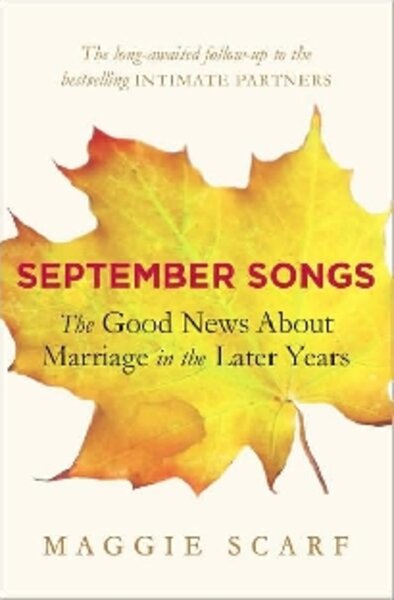September Songs
Loading...
A century ago, when brides and grooms vowed to stay together “till death do us part,” the average life span was just under 50 years. Today, couples walking down the aisle can look forward to a far longer future together.
Longevity has increased by nearly 30 years, creating a new stage of later adulthood that was almost nonexistent at the turn of the 20th century.
These “bonus years,” as Maggie Scarf reassuringly calls them in September Songs, offer rewarding possibilities at a time when those in their mid-60s can expect to live another 20 years or more in retired togetherness.
Curious about what this gift of a newly expanded life cycle means for marriage, journalist Scarf interviewed more than 50 couples in the “young-old” period between 50 and 75.
Some, like Nancy and David Sternberg, are veterans of stormy earlier years. David worked three jobs and was largely absent from his children’s lives. As Scarf explains, “They had fought about everything a married couple can fight about – money, the upkeep of the house, disciplining their children.”
But the couple stayed together.
Now, like other husbands and wives with children grown and careers winding down or finished, they have arrived at a point where they must “refind” each other. That involves focusing on what and who really matters to them at this time of life.
In extended interviews with six couples, Scarf gently and persistently asks about retirement, finances, health, religion, and family connections.
This transitional period – leaving the world of work voluntarily or involuntarily, relocating, and finding meaningful activity – often requires major adjustment.
Yet her findings are encouraging.
Most of these couples “exuded a sense of contentment and well-being – including some who’d been tense and argumentative 20 years earlier,” Scarf writes.
These couples also confirm studies showing that divorce is not always the necessary solution to an unhappy marriage. Researchers have found that 2 out of 3 unhappily married adults who avoided separation ended up happily married five years later.
What helped? Time passed. Problems abated or changed. Husbands and wives put one foot in front of the other, eventually achieving greater satisfaction.
Explaining that the emotional climate of marriage changes over the years, Scarf notes that older adults tend to live in the moment, which increases their sense of well-being. Older couples’ conflicts are less acute than those of younger couples.
In addition, long-term relationships with family and friends assume prime importance.
One husband describes this stage as “tranquil.” His wife calls it a “rebirth.” Another woman says she finds that this phase of life is infused with “an ever-increasing sense of peacefulness.”
At the same time, Steve and Jackie Winston still quarrel about her perfectionism and high standards for the house.
Yet a philosophical Steve says, “As we’ve gotten older I’ve become more mellow and capable of understanding Jackie in a far more meaningful way.”
Echoing that contentment, Claudia Hamilton tells Scarf, “I would actually say this is the happiest period of my whole lifetime.”
No one pretends that the bonus years are perfect. Couples still disagree about retirement, the emptying nest, sex, and of course money, the prime source of marital tension. Some also face serious health issues.
Yet for the most part these graying husbands and wives have come to share an abiding affection and appreciation for each other. Freed from the challenges of child rearing, they enjoy their grown children and delight in grandchildren.
The book grows less interesting when Scarf veers away from the couples into discussions peppered with phrases such as “a theory of socioemotional selectivity” and psychoanalyst Erik Erikson’s “generativity versus stagnation.”
But Scarf’s sensitive interviews offer valuable insights for baby boomers navigating the largely uncharted territory of the later years.
With the highest divorce rate in the world, American couples need all the encouragement they can get to weather marital storms and hang on until the clouds break and the sun shines again.
Noting the pleasure he takes in this time of life, the once-frenzied David Sternberg says, “We are two people in an equal deal and not a man and a woman in an ongoing futile quarrel over who is in control of the relationship. Right now we’re basically trying to figure out how we can get the most out of each day.”
That could be a recipe for a satisfying relationship for couples at every stage, both those in their bonus years and those at the altar, solemnly promising to stay together “as long as we both shall live.”
Marilyn Gardner is a Monitor staff writer.






